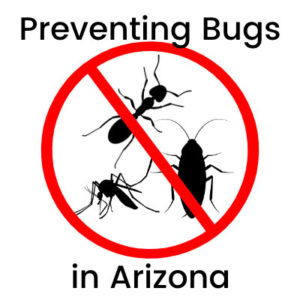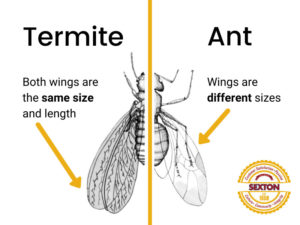Your Guide To Preventative Pest Control in AZ
 Do you want to keep your Arizona home clean and pest-free? It’s important to take a proactive, preventative pest control approach to targeting potential invaders at the source and eliminating them before they enter your house.
Do you want to keep your Arizona home clean and pest-free? It’s important to take a proactive, preventative pest control approach to targeting potential invaders at the source and eliminating them before they enter your house.
Unless you work in this industry, it can be difficult to understand the nuances. There are lots of different pests in Arizona, (over 15,000 to be exact!) and they’re attracted to different stimuli. Knowing how to identify them and keep them at bay might seem like a full-time job.
It is our full-time job, and we’re here to help. Today, we’re sharing all the tips for preventative pest control AZ homeowners need to know from Phoenix to Prescott and Tucson to Flagstaff.
What Attracts Arizona Pests?
The most ideal way to handle bugs is to never have to deal with them. So, what are the most effective ways to bug proof your Arizona home? We’re glad you asked.
Before we dive into how to approach preventative pest control in AZ, let’s start by discussing what brings the bugs to your house in the first place. If you look closely, you may discover several culprits that are beckoning nearby pests, encouraging them to settle in.
Some of the most common attractants include:
- Stagnant water
- Overflowing garbage bins
- Unattended garden beds
- Windows without screens
- Overripe fruits and vegetables left in the open
These problem areas might as well come with a welcome mat for pests. They’re the ideal place for them to gorge themselves, hide out, and return with all of their friends.
Take stagnant water, for instance.
It attracts mosquitoes by giving them an ample breeding ground. It also gives ants a source of liquid to drink, which can encourage an infestation. Left untreated, it can even cause mold to grow in your yard.
The same applies to the other issues on this list. Garbage and garden bins make great food sources for pests, and open windows allow them to fly right into your home, where lots of other goodies await. While you can’t completely safeguard your property against them, you can take measures to protect your home as much as possible.
It all starts with understanding what pests need to survive and thrive, and eliminating those things from your space. Let’s take a closer look.
What Do Pests Need to Survive?
Ultimately, the needs of most pests don’t differ too much from those of humans. They need food, water, and shelter to live. Here’s a quick breakdown.
Food
Pests need to eat to survive. Some insects, such as ants and termites, live in complex colonies, where they’ll work together to share the chore of gathering food.
As they search for morsels, they’re especially interested in sugar. Some pests, like wasps, are attracted to natural sugars, such as those found in flower nectar. However, ants are most curious about artificial sugars, including those on your pantry shelves.
Most of the time, if you see a colony of ants marching toward a crumb, it’s not the carbs or protein they’re after — it’s the sweet stuff.
Then, there are pests that feed on cellulose, such as termites. These pests contain an elevated amount of Achaea bacteria inside them, which allows them to break cellulose down into essential nutrients. Decaying, rotten wood is the perfect source because it’s already soft and easy to digest.
Water
Like us, most pests also need water! Many pests, insects, and bugs need water and humidity to survive, so they are naturally attracted to moisture and condensation.
Most can survive just fine just by absorbing the humidity in the air. This explains why you see more pesky gnats, mosquitoes, and fruit flies in the summertime.
Not only does moisture satiate these pests, but it also facilitates their breeding cycles. Standing water is a perfect place for mosquitos to multiply. Small insects produce tiny eggs and larvae. Most are not much larger than a microorganism, and they tend to dry out quickly.
To prevent this from occurring, most insects will seek a good source of moisture before laying their eggs. Be sure to fix any plumbing leaks and install a good, effective drainage system that can help prevent bugs from inhabiting your home during or after a storm.
Shelter
Pests need adequate shelter for protection against both cold and heat. When they’re outside, many will nest under the ground. Indoors, you can usually find them huddled into corners or other hidden spots.
Not only does shelter give them a sense of protection, but it also gives them space to breed. Most pests have relatively short lifespans, and breeding is their primary activity, apart from eating.
How to Get Rid of These Life Sources
Once you know what local pests need to survive, you can start taking steps to remove those items from your home.
Let’s start with food!
Clean Out Your Fridge, Trash, & Cabinets
Not only is it just good practice in general, but cleaning out your fridge, taking out the trash, and making sure that your cabinets are food-free (or at least regularly cleaned and checked for crumbs) is a sure-fire way to help prevent unwanted pests.
Take out the trash daily – and this includes the recycling. Any trash that you have can (and will) attract bugs and insects to your home. It’s best to prevent that by taking out the trash and being aware of anything that might be going bad in your fridge or cabinets.
If you keep your garbage bins outside, remember to empty them regularly. Make sure they close completely and never overflow.
Inside your home, keep all of your food safely sealed and stored in airtight containers inside the refrigerator or pantry. Leaving fruit to ripen on the counter might sound like a good idea, but it can also attract any flies, gnats, or other pests that find their way into your home.
It’s also important to keep your kitchen (and any other places you have food) tidy. Make sure to sweep up crumbs, vacuum the floors, clean up any spills, and clean your dishes daily. You should also clean out your microwave, oven, and toaster on a monthly basis. If you have pets, make sure to keep all of their food, toys, bedding, and other accessories clean in order to prevent any potential bug attraction.
Finally, remove all sources of standing water from around your home. Empty all buckets, don’t overwater your yard, and fix any leaky gutters or downspouts. If your lawn still appears to be retaining water, you may need to speak with a professional landscaper about adding mulch, compost, or a more efficient drainage system to eliminate the excess moisture.
Identifying Points of Entry
Finally, let’s talk about shelter. Start by walking around the exterior of your home.
Cut back your greenery away from the house, and eliminate other piles of debris around your perimeter, including firewood. This can discourage pests from gathering, breeding, and residing right near your entrance.
Inside, think about all of the ways that pests could enter your home, and seal those spots up. Possible steps that you might need to take include:
- Check window screens for damage
- Install a bug proof screen on doors or windows
- Seal cracks and gaps in your exterior
- Repair leaky piping
- Keep windows and doors closed
- Seal utility openings (pipe/wire entry points, outdoor faucets, laundry vents, gas meters)
These steps make it more difficult for pests to cross your threshold and seek shelter in your home. While they’re important to remember year-round, they’re especially critical in the summer. Most pests can’t stand the heat and will look for any opportunity to cool down indoors.
Preventative pest control can help keep them far away, so they’re less likely to consider your home a viable place to seek shelter and find relief.

Fall/Spring Cleaning
Bugs and pests love to hide and build communities in leaves, mulch, and wood piles. During seasons where you are more likely to keep piles of wood, leaves, or mulch in your yard, keep in mind that you should not use mulch near your home’s foundation. It’s also imperative to mow your lawn regularly and keep the grass short around your home. Make sure to keep your plants trimmed and in good shape.
The reason behind keeping all of your shrubbery short and trimmed is because when these plants come close to your home, they serve as an entryway for unwanted guests.
Welcome Pest Predators
While it may not be the first approach you think of when it comes to pest prevention, encouraging birds and bats to reside around your home can be incredibly useful. Birds and bats are both predators to most pests, so you’re allowing the circle of life to work it’s magic and protecting your home from a pest invasion.
In order to get birds to take up residence near you, create spaces where they can build nests like trees or shrubs. It’s also important that you make sure there is a place where they can get water. For bats, you can build bat houses where they can sleep during the day.
Specific Problem Pests to Know
In Arizona, there are certain pests that tend to invade more often than others. Let’s take a look at how they can get into your home and how to keep them out.
Termites
Termites is a word that will undoubtedly evoke fear into the souls of homeowners everywhere. However, termites are actually quite important to nature because they mostly feed on dead wood and plant materials which, once broken down, can actually help promote plant growth. While this is useful in nature, having termites in your home can result in a very expensive home makeover.
What Termites Love About Your Home
As we previously mentioned, termites love wood. That means that, if you have a wooden deck, or wood piles in your yard, or simply a house built of wood, your home is attractive to termites. If you have wood piles, it’s a smart idea to keep the piles at least 20 feet away from your home. 
If your home is in Arizona, you are more likely to encounter termites because, out of the 46 known termite species in the United States, at least 17 of them have been found to reside in Arizona.
Termites can pose a serious threat to your home and are not easy to spot until they’ve already done some serious damage to the wood in your home. That’s why it’s important to have your home checked by a professional exterminator on a yearly basis to ensure that there are no termites in your home. Additionally, if the exterminator does find that your home has termites, they can help you to exterminate them efficiently and effectively.
Ants
If you have any small holes, gaps, or cracks in your exterior, ants will seek them out and invade. Identify any such areas, and seal them up securely to prevent entry, paying close attention to any areas where pipes, wires, or conduits enter the house.
In addition, prune your tree limbs back so they don’t come near your house. Ants are smarter than we give them credit for and will use branches to get close to your home.
Rodents
Like ants, rodents usually get into homes through cracks and holes in the exterior. Small pests like squirrels or mice like to make themselves at home in small, dark places like attics. Installing barriers can help prevent that from happening. They can travel through your walls and floors, as well as your foundation, and can also enter from the attic.
They’re this nimble due to their flexible body shape, which allows them to squeeze through impossibly small openings. To keep them away, start by blocking all of your potential entry points.
Look for cracks in your foundation, and repair them immediately. Then, inspect the joints around your window and door sills, caulking any cracks that might allow them to enter.
Flies
Flies can also enter your home through cracks in the foundation. They’ll look for small openings near your plumbing, pipes, and vents and crawl inside when possible. If you have any holes in your air conditioner filters or cracks around the unit, they’ll find those, too.
However, most prefer to take a simpler route: an open door! While it might feel nice to leave your doors or windows cracked in nice weather, remember that pests are always looking to hitch a ride inside.
Screens can keep them out, but make sure there aren’t any holes or rips where the openings are larger than normal. By replacing faulty screens, keeping your entrance points closed, and repairing any cracks in your walls, you can usually keep their populations at bay.
Mosquitoes
Like flies, mosquitoes enter your home through open doors and windows. If your garage door doesn’t seal completely, they can fly into that space to seek shelter from wind and unfavorable weather conditions.
They’re also adept at finding even the smallest tear in your screens, so remember to repair all the ones on your windows and doors as soon as you notice the damage.
Preventing and Getting Rid of Cockroaches
First, how do you know if you’re dealing with cockroaches? The benefit here is that cockroaches are often relatively large and easy to spot. However, if you have yet to see a cockroach, but are seeing droppings that resemble pepper flakes, it’s a sign that you might have a cockroach.
What Cockroaches Love About Your Home
Cockroaches love water. In fact, water is an excellent breeding source for cockroaches. In order to discourage cockroaches from breeding in your home, you should avoid having floor drains, leaks, or puddles.
Cockroaches are also attracted to the scent of paper, so try to avoid piles of papers, books, or magazines – especially in a room where it is dark more often than not.
Cockroaches are infamously difficult to kill, which is why when dealing with cockroaches, you need to be willing to get a little creative.
In order to catch cockroaches, you need to provide them with something enticing enough to lure them in and strong enough to get rid of them. A simple do-it-yourself trap you can create is taking sugar or cocoa powder and mixing it with a chemical like diatomaceous earth (a natural pest killer).
It’s also not a bad idea to invest in door sweeps because the tiny, yet dense, nylon bristles can help create a protective barrier that keeps pests like cockroaches out of your home.
Why Professional Pest Control Is Best
These preventative pest control tips can help you protect your home from pesky intruders. However, there are certain steps that are best left to a trained, experienced pest control company.
These experts are well-versed in the most common Arizona pests. They’ll know exactly what to look for as they inspect your home inside and out. If they do find an active infestation, they will know how to treat it effectively.
This includes using special chemicals and techniques that will completely eliminate the pests and make sure they don’t come back. Then, they’ll continue to treat your home consistently, delivering routine preventative maintenance to control pest populations for good. This is a more effective approach than most one-time DIY solutions, which might work at first, but are rarely powerful enough to solve the problem.
Can You Totally Bug Proof Your Home?
It’s probably safe to assume that no homeowner wants to have any bugs or pests in their home. If you’re a homeowner, you’ve likely wondered if it’s possible to totally bug proof your home. In short, the answer is no. However, if you take preventative steps listed in this guide, you are less likely to encounter pests in your home.
Additionally, by hiring a professional to check your home for potential pests every year, you can save yourself time, money, and frustration in the future.
For Arizona homeowners specifically, there are certain pests that can be more dangerous than others (for example, scorpions). If you own a home in Arizona, it is best practice to have your home checked often by a professional in order to keep your home, and your family, safe from pests.
Your Guide to Preventative Pest Control in AZ
At Sexton Pest Control, We believe You deserve to rest easy, knowing that your Arizona home is safe, clean, and pest-free. What is preventative pest control AZ? In short, it means acting before you need to, looking for ways to protect your home ahead of an infestation.
